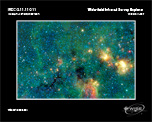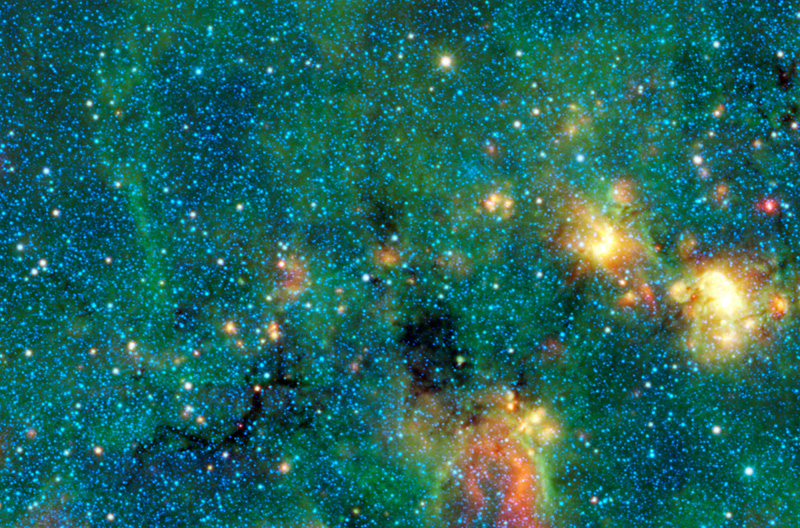



|
August 19, 2011 - IRDC G11.11-0.11: Dark Murky Clouds in the Bright Milky Way Typically if an astronomer wants to look into or through a thick dark cloud in space, they will choose to look in infrared light. However, in this infrared image from NASA’s Wide-field Infrared Survey Explorer, or WISE, we can see that some clouds are so cool and thick that even infrared can’t penetrate them. The black areas in this image—called infrared dark clouds (IRDCs)—are exceptionally cold, dense cloud cores seen in silhouette against the bright diffuse infrared glow of the plane of the Milky Way. They’re great examples of why it is so useful for astronomers to be able to observe in many different wavelengths of light. If you were to look at this same region of the sky through a backyard telescope you would see a sea of stars packed together, similar to the thousands of blue stars seen here. You might also notice small patches of darkness that appear to block out the stars behind them. But what you wouldn’t see are these beautiful clouds colored green, yellow and red, as in this image from WISE—those are only seen in infrared. In fact, the places where you see dark patches with your eyes are often the places where WISE sees bright clouds with its infrared ”eyes.” What’s dark to our eyes is often bright to WISE because those clouds are dense enough to block visible light,but not dense enough to block the longer wavelengths of infrared light—and too cool to shine in visible light but still warm enough to glow brightly in infrared light. However, that same basic darkening effect is happening even in this infrared image. The dark areas here are places where the gas is extremely compact and chilly, so much so that it is opaque even in the infrared wavelengths that WISE sees. To see them glow we must look in even longer wavelengths. IRDCs are so dense that if you were located in the middle of one of them, you wouldn’t be able to see anything – no stars, no galaxies, only darkness. The density in these clouds is high enough to lead to the formation of new stars and planets. This image was made from observations by all four infrared detectors aboard WISE. Blue and cyan (blue-green) represent infrared light at wavelengths of 3.4 and 4.6 microns, which is primarily light from stars. Green and red represent light at 12 and 22 microns, which is primarily light from warm dust. Image Credit: NASA/JPL-Caltech/UCLA |
|||||||||||||||||||
|
||||||||||||||||||||
|
|||

